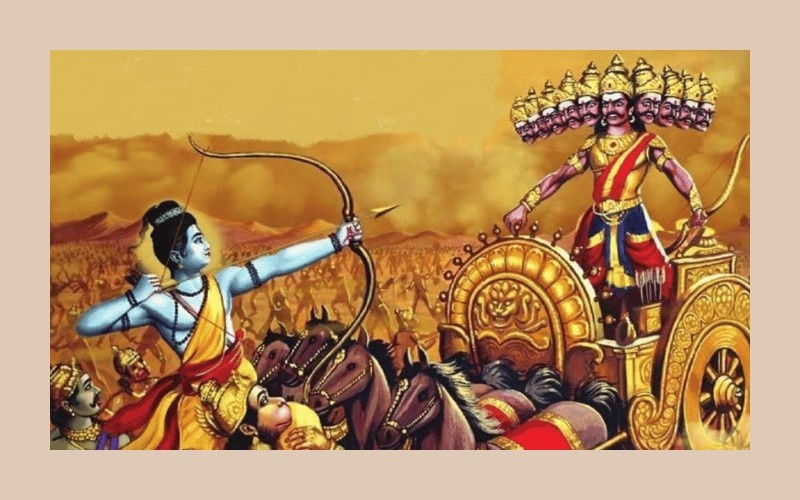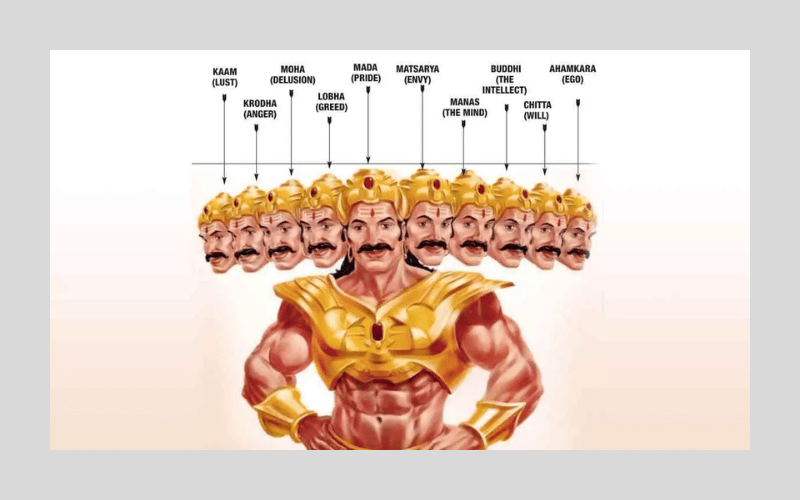According to the ancient Indian texts of Ramayana, Ravana stands as a wise and ambitious, and powerful demon lord who reigned over Lanka. Such deities in Hindu mythology demonstrate contradictory traits, as their exceptional power exists alongside their tragic weaknesses. Throughout centuries, scholars and devotees, along with storytellers, have been intrigued by Ravana’s ten heads, which exist as important symbols within Hindu philosophy and mythology explanations.
The Mythological Origins of Ravana’s Ten Heads
One of the most recognizable traits of Ravana lies in his ten heads. Ravana appears in the Ramayana epic with ten heads which serve as metaphors for his superb power alongside his extensive wisdom as well as his controlling mastery over multifaceted skills. The different heads on his body symbolize distinct elements of what Ravana knows and who he is.
Different scholars have interpreted Ravana’s ten heads as physical manifestations of his dominant control over ten types of knowledge that enable him to grasp secret universal knowledge. Different scholars say these ten faces of Ravana represent both his understanding of material senses and spiritual knowledge because they symbolize his ten indriyas as well as his control of the ten dasha-vidha.
Hindu mythology emphasizes the importance of number ten which symbolizes both the completion of things and the eternal life processes. The ten heads of Ravana symbolize his complete control of his mind and body as well as his spirit. Ravana demonstrates mastery over dharma through his ten heads even though his lack of action in line with those teachings leads to his downfall.
The Symbolic Meaning of the Heads
- Mastery of Knowledge and the Vedas
Through his devotion to Lord Shiva Ravana earned divine blessings after conducting long periods of spiritual meditation. Ravana demonstrates his extensive mastery of the Vedas by having ten distinct heads. In Hindu philosophy the four categories of knowledge match the ten heads: artha stands for wealth and kama represents pleasure while dharma identifies righteousness and moksha signifies liberation.
By understanding the Vedic scriptures Ravana gained abilities to perform potent mantras along with magical rites thus gaining supreme dominance over the world. His smart mind established dominance that reached beyond other divine beings.
2. Ten Senses (Dasha-Indriya)
According to another description, Ravana possesses ten heads that symbolize his control over the ten senses. Hindu philosophy uses ten sensory categories to explain human perception through five senses of sight, hearing, touch, taste, and smell, as well as five organs of action which include speech, hands, feet, excretion, and reproduction. The multiple heads of Ravana symbolize his flawless domination of human perception alongside the ability to control physical and spiritual realms.
Through his ability to control all senses Ravana obtained great power which eventually led to his destruction. His control over worldly aspirations succeeded but he failed to master negative human traits which included pride and anger together with ego. Negative emotions eventually resulted in his death.
3. The Five Emotions (Panchavayu)
Ravana maintains an additional layer of significance because of his relationship with the five major emotional forces which include anger and greed and attachment and pride and jealousy. Hindu philosophy explains these emotions as responsible for creating human suffering. Due to his power and wisdom Ravana lost himself to negative emotions making him thereby vulnerable to downfall.
Through his ten heads, Ravana shows his ambition to exercise complete hegemony over all aspects of human life, from positive to negative elements. When Ravana failed to maintain emotional equilibrium, his power addiction grew out of control, thus making him disregard the ultimate benefit for humanity.
4. A Representation of the Cosmic Forces
The ten heads of Ravana represent his connection to cosmic universal forces that control the universe. Interpretations suggest that Ravana’s ten skulls symbolize ten great cosmic elements such as fire, water, earth, air and ether in addition to light, darkness, time, space along with consciousness. According to this interpretation Ravana exercises absolute element domination as he transcends physical reality to access metaphysical powers.
Ravana ruled Lanka while possessing ten heads to demonstrate his mastery over North, South, East, West, Northeast, Southeast, Northwest, Southwest, Up, and Down directions. Ravana appears as a character with exceptional power along with deep political influence because he demonstrates his capability to master natural forces.
5. Ravana as the Ten-Headed Demon of Ego
The ten heads of Ravana represent his connection to cosmic universal forces that control the universe. Interpretations suggest that Ravana’s ten skulls symbolize ten great cosmic elements such as fire, water, earth, air and ether in addition to light, darkness, time, space along with consciousness. According to this interpretation Ravana exercises absolute element domination as he transcends physical reality to access metaphysical powers.
Ravana ruled Lanka while possessing ten heads to demonstrate his mastery over North, South, East, West, Northeast, Southeast, Northwest, Southwest, Up, and Down directions. Ravana appears as a character with exceptional power along with deep political influence because he demonstrates his capability to master natural forces.
The Role of Ravana in Hindu Philosophy
Ravana represents multiple conflicting traits in his personality. The character holds dual traits as he represents scholastic wisdom while being a criminal figure alongside his dedication to Lord Shiva and misuse of his authority. Ravana acts as a philosophical testament to humans because he exhibits both admirable and reprehensible traits.
Knowledge exists without enlightenment and liberation because its ten heads demonstrate this fact. Only by applying learned knowledge properly through actions that express humility and compassion, and righteousness can one develop their character. The loss of Ravana results from his failure to balance his intelligence with wisdom and humility, instead of being caused by his knowledge itself.

Ravana’s Devotion to Lord Shiva
Ravana’s religious reverence to Shiva remains one of his most defining qualities although he displayed other behavioral faults. The powerful Shiva Tandava Stotra emerged from his pen which he composed to honor Lord Shiva while performing tremendous devotional rituals. Each of Ravana’s ten heads symbolizes his absolute devotion to Shiva because they represent prayers which he made to the deity.
Ravana truly devoted himself to Shiva in his worship, yet his improper use of divine power teaches about proper spiritual conduct. Devotees should recognize that moral guidance is vital when using divine blessings since Ravana’s story in Hindu philosophy demonstrates the dangers of power abuse without ethical direction.
Conclusion
The ten heads of Ravana symbolize his extensive intelligence as well as his elemental mastery and sensory domination while signaling his unrestrained arrogance. Ravana possesses enormous power which contrasts with his excessive pride that ends in his catastrophic loss. Ravana’s story demonstrates to Hindu students that power must be balanced with humility and righteousness to maintain success.
The multiple heads of Ravana symbolize human complexity which illustrates the essential requirement for uniting wisdom with feelings and deeds in harmonious ways. The ten heads stand as a forceful connection between the tremendous abilities of human beings and the necessity of gaining spiritual clarity to escape prideful errors.
The ten heads of Ravana show how his powerful status contains multiple attributes that both represent his wickedness and highlight his diverse abilities.
The Contemporary Relevance of Ravana’s Symbolism
Currently, Ravana’s tale about ten heads fulfills a purpose greater than ancient mythology because it provides deep instructions about human behavior and leadership methods, and ethical conduct. Each head symbolizes the multiple conflicting challenges people encounter during their contemporary existence, which include ambition versus ethics and knowledge versus wisdom, as well as power versus responsibility. Ravana functions as a vital warning example for contemporary leader-shapers as well as intellectual authorities who excel in competency yet fail to demonstrate ethical integrity.
Through its narrative, the story demonstrates that outer accomplishments in scientific fields and political realms, and spiritual areas, need inner virtues that embrace humility while being mindful of human boundaries. Ravana’s destiny proves that supreme intelligence without appropriate equilibrium results in destruction.
Ravana in Regional Traditions
Several Indian traditions follow divergent interpretations of how they view Ravana. The Ramayana version found across southern India and parts of Southeast Asia shows Ravana as an anti-hero who was a great ruler whose character fell through fatal errors. Many stories throughout Lanka (modern Sri Lanka) praise Ravana as a ruler who advanced scientific knowledge, together with medical practices (Ravana Samhita) and musical instruments (Ravana Veena).
Ravana’s double nature makes his personality sophisticated in complex ways. Ravana functions as an evil symbol that simultaneously reflects the subtle difference between greatness accompanied by downfall and enlightenment met by egoism.
The ten heads of Ravana symbolize how a multiple-desired mind needs conscious judgment more than consuming its desires. The way society views Ravana’s legacies becomes a matter of determining which aspects constitute virtue versus villainous nature. Through his shortcomings, he showed devotion to scholarship and effective rule, and exceptional expertise in arts and sciences. Culture-dependent portrayals of this figure demonstrate how personal views about good and bad can change based on historical moments and contextual understanding. Through his intellectual brilliance, devotion to Shiva, and command of the Vedas, his identity emerges as a fascinating combination of wise humility and Self-celebrating resistance.














